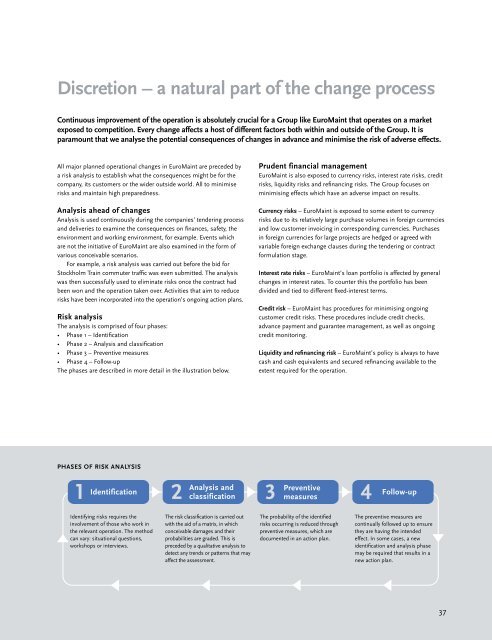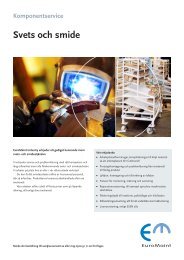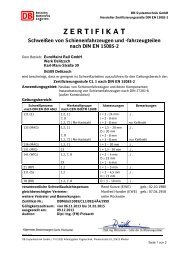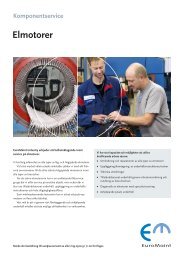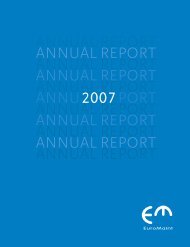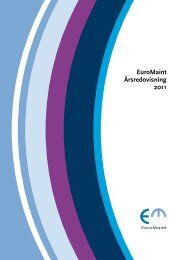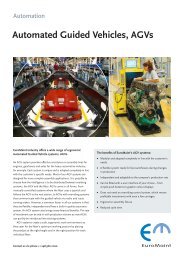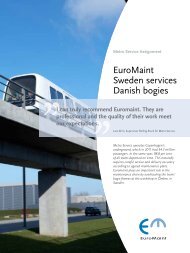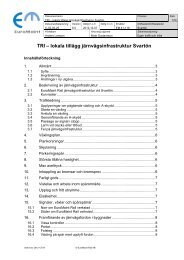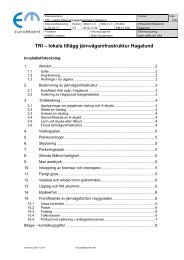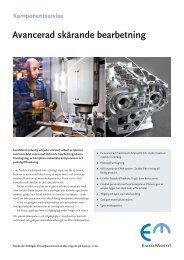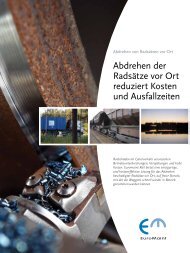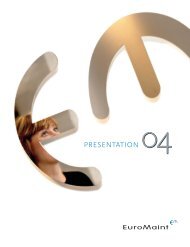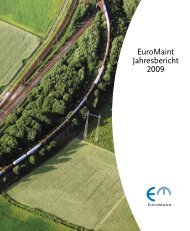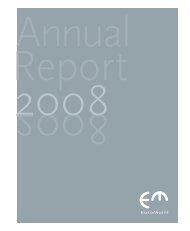Annual Report 2006 - Euromaint
Annual Report 2006 - Euromaint
Annual Report 2006 - Euromaint
Create successful ePaper yourself
Turn your PDF publications into a flip-book with our unique Google optimized e-Paper software.
Discretion – a natural part of the change process<br />
Continuous improvement of the operation is absolutely crucial for a Group like EuroMaint that operates on a market<br />
exposed to competition. Every change affects a host of different factors both within and outside of the Group. It is<br />
paramount that we analyse the potential consequences of changes in advance and minimise the risk of adverse effects.<br />
All major planned operational changes in EuroMaint are preceded by<br />
a risk analysis to establish what the consequences might be for the<br />
company, its customers or the wider outside world. All to minimise<br />
risks and maintain high preparedness.<br />
analysis ahead of changes<br />
Analysis is used continuously during the companies’ tendering process<br />
and deliveries to examine the consequences on finances, safety, the<br />
environment and working environment, for example. Events which<br />
are not the initiative of EuroMaint are also examined in the form of<br />
various conceivable scenarios.<br />
For example, a risk analysis was carried out before the bid for<br />
Stockholm Train commuter traffic was even submitted. The analysis<br />
was then successfully used to eliminate risks once the contract had<br />
been won and the operation taken over. Activities that aim to reduce<br />
risks have been incorporated into the operation’s ongoing action plans.<br />
Risk analysis<br />
The analysis is comprised of four phases:<br />
• Phase 1 – Identification<br />
• Phase 2 – Analysis and classification<br />
• Phase 3 – Preventive measures<br />
• Phase 4 – Follow-up<br />
The phases are described in more detail in the illustration below.<br />
PhaSES OF RISK aNaLySIS<br />
Identifying risks requires the<br />
involvement of those who work in<br />
the relevant operation. The method<br />
can vary: situational questions,<br />
workshops or interviews.<br />
The risk classification is carried out<br />
with the aid of a matrix, in which<br />
conceivable damages and their<br />
probabilities are graded. This is<br />
preceded by a qualitative analysis to<br />
detect any trends or patterns that may<br />
affect the assessment.<br />
Prudent financial management<br />
EuroMaint is also exposed to currency risks, interest rate risks, credit<br />
risks, liquidity risks and refinancing risks. The Group focuses on<br />
minimising effects which have an adverse impact on results.<br />
Currency risks – EuroMaint is exposed to some extent to currency<br />
risks due to its relatively large purchase volumes in foreign currencies<br />
and low customer invoicing in corresponding currencies. Purchases<br />
in foreign currencies for large projects are hedged or agreed with<br />
variable foreign exchange clauses during the tendering or contract<br />
formulation stage.<br />
Interest rate risks – EuroMaint’s loan portfolio is affected by general<br />
changes in interest rates. To counter this the portfolio has been<br />
divided and tied to different fixed-interest terms.<br />
Credit risk – EuroMaint has procedures for minimising ongoing<br />
customer credit risks. These procedures include credit checks,<br />
advance payment and guarantee management, as well as ongoing<br />
credit monitoring.<br />
Liquidity and refinancing risk – EuroMaint’s policy is always to have<br />
cash and cash equivalents and secured refinancing available to the<br />
extent required for the operation.<br />
The probability of the identified<br />
risks occurring is reduced through<br />
preventive measures, which are<br />
documented in an action plan.<br />
The preventive measures are<br />
continually followed up to ensure<br />
they are having the intended<br />
effect. In some cases, a new<br />
identification and analysis phase<br />
may be required that results in a<br />
new action plan.<br />
37


